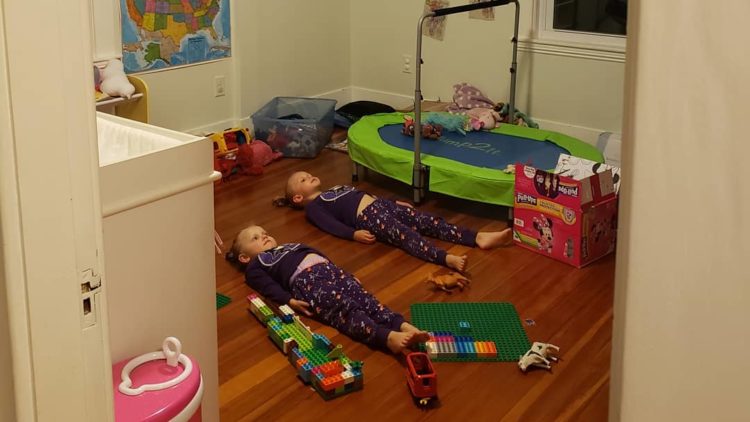Experts weigh in on this advice for ending your kids’ nagging

I’m no parenting pro; just a veteran mom and involved grandmother. When I read or hear about a positive approach to dealing with kids, I’m all ears. That being said, many so-called parenting hacks are not all they’re cracked up to be. In my estimation, the proof is in the pudding.
When I read a tip from Amy McCready, author and Founder of Positive Parenting Solutions, I thought it best to hand it off to my daughter. With a 6-year-old, a not-quite-4-year-old and a 2-year-old, she is deep in the trenches of parenting. Who better to give it a go?
The tip in question is using three words—“Asked and answered”—whenever your child uses what she calls “nagging,” or repeatedly asking a question to which you have already responded.
How To Use Those Three Magic Words
There is a method to this approach, which involves getting eye to eye with your child and explaining what asked and answered is the first time.
When your child wants to dig a hole in the yard, for example, you explain that he has already asked and you have already answered, following up with a question such as, “Do I look like the kind of mom/dad/teacher who will change her/his mind if you ask me the same thing over and over?”
To any further nagging, you simply respond, “Asked and answered.” End of story.
But Does It Work?
My daughter tried the technique with mixed results. The youngest has not quite reached the nagging stage yet. The middle child responded with a grunt, a huff and an exasperated, “Fine!” As for the oldest, who is a combination of philosopher and defense attorney, it led to a near-meltdown, as he was frustrated that he could neither plead his case nor express his feelings and thoughts on the situation.
Still unclear about the effectiveness of this technique, I decided to seek some expert opinions. They shared what they see as pros and cons of this parenting tip.
Dr. Oksana Hagerty is an educational and development psychologist who serves as a learning specialist at Beacon College in Leesburg, Florida. She sees two positives to this technique. “First, it does detail your needs as a listener and the past history of the conversation,” she says. “Why is it important? Because when speakers have a lot to remember, they find it difficult to take into account exactly these two factors. In other words, your kid, being engulfed by his/her immediate need, when all his/her attention is focused on striking a deal may not remember that you did answer the question and that you do not change your mind even when asked many times.”
“Second, more in terms of non-verbal cues,” Hagerty continues, “this technique does mention ‘getting eye-to-eye’ with your kid. I would expand on this advice and emphasize that you quite literally have to stop whatever you are doing and make sure you have an eye contact before you talk. Negotiating while chopping onions or looking for the best cut of meat in a food store is not going to be effective.”
“As a parent of a toddler and an infant, I see inherent value to responding to their requests in a consistent, yet caring manner,” shares Eleazar Cruz Eusebio, Psy.D., NCSP, Chair of the Department of School Psychology at The Chicago School of Professional Psychology. “Although older children may really expect an explanation, most young children and toddlers simply do not developmentally understand why they may be continually given an emphatic ‘No.’ If this is the usual response from their parent, a toddler is likely to continue asking until the parent simply gives in or the answer response changes. After all, if it takes a few extra breaths, it might be worth it! I’m guilty of it, but from a psychological perspective, the toddler has essentially permeated your boundaries.
“In the same breath,” he goes on to say, “I’ve found that being firm and consistent is effective, but does not always work for the persistent or highly sensitive toddler. As s/he begins to grow and understand their options and expectations, I believe it helps both parents and their children to include them in the process of setting and following boundaries.”
Michelle Cutler, Ph.D., Associate Professor of Clinical Psychology Chicago School of Professional Psychology shares her apprehension regarding this approach.
“While I completely understand a parent’s frustration with their child’s persistent and consistent requests and the need to teach our children that ‘no means no,’” she says, “my concern with this approach is that it does not take into account the child’s feelings, needs or wants. Especially without paying attention to our tone as parents (when we ourselves are feeling frustrated), it can be quite hurtful and dismissive.”
“Kids will ask and ask (persistence can be a positive trait!), but this habit will eventually go away if you are consistent with your limits, avoiding caving in,” says Cutler. “We can continue to give our kids limits and boundaries that are absolutely necessary—I don’t want holes in my backyard either—but in a way that teaches them that we care about what they want, and what they have ideas about doing, and therefore who they are.
“Think about how we would feel if we approached our supervisor at work with an idea,” she continues. “Our supervisor wasn’t initially positive to it, but we tried again with a different approach and were told, ‘Asked and answered.’ Not so respectful, right? Not encouraging us to bring up other ideas for sure, and it likely wouldn’t make us feel appreciated, valued or likely to share our opinion again.
“Our kids would likely feel the same way with that response,” she concludes. “It’s important to speak to our children in the way we would like to be spoken to. This not only conveys how we feel about them and their ideas, but models for them how to talk to others.”
Is There A Better Alternative?
“Here’s something to keep in mind,” Cutler says. “At least your child asked you about digging the hole instead of just doing it! I would always praise and thank them for that. It shows they know that you’re in charge. Just a quick, ‘Thanks for asking, I’m glad you came to me first.’”
She also expresses the importance of responding to a child’s initial request in a meaningful manner. She suggests:
- Asking for and listening to children’s explanations about why they want something.
- Validating what they are saying (“I know that sounds super-cool and you’re excited about digging a hole…”)
- Explaining your point of view about why that’s not OK (NOT in a long lecture, just a couple of sentences, “…but I don’t want there to be a hole in the yard. I care about how our yard looks and someone could get hurt if they stepped in it.”)
- Setting the limit (“So I’m sorry, but you can’t do that.”)
Eusebio seems to sum up what my daughter experienced with her children. “There really is no one method or panacea to what a parent ought to do in every situation,” he acknowledges. “Every child is different and situations are infinite.”
His best advice?
“Be firm, consistent when possible, yet caring, while attempting to involve children in their choices and reactions to their requests,” he recommends. “Although most adults likely experience the continual requests as annoying, the child still deserves more than a, ‘Because I said so.’ There’s simply no meaning or respect in that response and the message to the child is that you have and will absolutely never have any say and that’s simply the way that it is.”
The good news is that working through this issue is beneficial to parent-child relationships.
“The process of setting boundaries can ultimately lead to parents and children learning and better understanding one another,” states Eusebio, “and, in the process, forging a stronger relationship based on respect and responsibility.”
[h/t: lifehacker]







